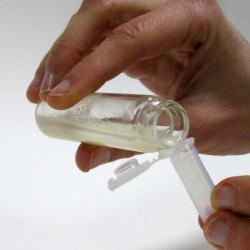Source Institutions
Source Institutions
Add to list Go to activity
Activity link broken? See if it's at the internet archive

In this activity, learners explore deoxyribonucleic acid (DNA), a nanoscale structure that occurs in nature. Learners extract a sample of DNA from split peas and put the sample in an Eppendorf tube to take home. Learners discover that nanoscientists study DNA to understand its biological function and use it to make other nanoscale materials and devices.
- 30 to 45 minutes
- 10 to 30 minutes
- Over $20 per group of students
- Ages 6 - adult
- Activity, Demonstration, Experiment/Lab Activity, Lesson/Lesson Plan
- English
Quick Guide
Materials List (per group of students)
- Powerpoint or hard copies of images
- Prepared strips of paper and adhesive envelope labels
- Pea mixture in labeled squirt bottles
- Buffer solution in labeled dropper bottles
- Alcohol in labeled squirt bottles
- Glass vials (or test tubes and a holder)
- Eppendorf tubes (1.5 ml or 2 ml)
- String or yarn
- Scissors
- DNA extraction protocol handout
- Safety glasses
- Paper towels (for spills)
- Dried split peas
- Cold water
- Blender
- 1 c measuring cup
- Mixing bowl or other container
- Strainer that fits into the mixing bowl
- Labeled squirt bottles (~500 ml)
- Funnel (optional)
- Cold water
- Dishwashing liquid (detergent)
- Salt
- 1/2 cup measuring cup
- 1 t measuring spoon
- 1/8 t measuring spoon
- Mixing bowl or other container
- Spoon
- Labeled dropper bottles (~100 ml)
- Isopropyl alcohol (at least 70%)
- Labeled squirt bottles (~250 ml bottles)
- Strips of paper or register tape
- Self-adhesive envelope labels
- Marker
Subjects
-
Engineering and Technology
-
Engineering
- Bioengineering/Biomedical Engineering
- Nanotechnology
- Technology
-
Engineering
-
Life Sciences
-
Heredity and Genetics
- Human Genetics
- DNA Structure and Function
-
Heredity and Genetics
-
Mathematics
-
Measurement
- Units of Measurement
- Size and Scale
-
Measurement
-
Physical Sciences
-
Chemistry
- Chemical Reactions
-
Chemistry
-
The Nature of Science
-
The Scientific Process
- Conducting Investigations
-
The Scientific Process
Informal Categories
- Food and Cooking
Audience
To use this activity, learners need to:
- see
- touch
Learning styles supported:
- Involves hands-on or lab activities
Other
Components that are part of this resource:
- DNA Nanotechnology Lesson Plan
- DNA Nanotechnology Lesson Plan
- DNA Nanotechnology Guide
- DNA Nanotechnology Guide
- DNA Nanotechnology Presentation
This resource is part of:
Access Rights:
- Free access
By:
Rights:
Funding Sources:
- National Science Foundation, 0532536
- National Science Foundation, 0940143
